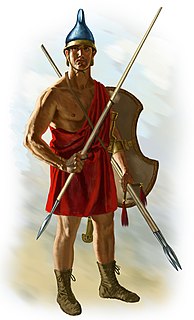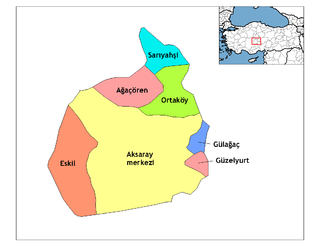See also
| This disambiguation page lists articles associated with the title Pelte. If an internal link led you here, you may wish to change the link to point directly to the intended article. |
A pelte is a light shield used by ancient Greek peltasts.
Pelte may also refer to :
| This disambiguation page lists articles associated with the title Pelte. If an internal link led you here, you may wish to change the link to point directly to the intended article. |

A shield is a piece of personal armour held in the hand, which may or may not be strapped to the wrist or forearm. Shields are used to intercept specific attacks, whether from close-ranged weaponry or projectiles such as arrows, by means of active blocks, as well as to provide passive protection by closing one or more lines of engagement during combat.

The ancient Greek language includes the forms of Greek used in Ancient Greece and the ancient world from around the 9th century BC to the 6th century AD. It is often roughly divided into the Archaic period, Classical period, and Hellenistic period. It is antedated in the second millennium BC by Mycenaean Greek and succeeded by Medieval Greek.

A peltast was a type of light infantry, originating in Thrace and Paeonia, who often served as skirmishers in Hellenic and Hellenistic armies. In the Medieval period, the same term was used for a type of Byzantine infantryman.

Iphicrates was an Athenian general, who flourished in the earlier half of the 4th century BC. He is credited with important infantry reforms that revolutionized ancient Greek warfare by regularizing light-armed peltasts.

The phalanx was a rectangular mass military formation, usually composed entirely of heavy infantry armed with spears, pikes, sarissas, or similar pole weapons. The term is particularly used to describe the use of this formation in Ancient Greek warfare, although the ancient Greek writers used it to also describe any massed infantry formation, regardless of its equipment. Arrian uses the term in his Array against the Alans when he refers to his legions. In Greek texts, the phalanx may be deployed for battle, on the march, or even camped, thus describing the mass of infantry or cavalry that would deploy in line during battle. They marched forward as one entity.

Aksaray is a city in the Central Anatolia region of Turkey and the capital district of Aksaray Province. According to 2009 census figures, the population of the province is 376 907 of which 171,423 live in the city of Aksaray. The district covers an area of 4,589 km2 (1,772 sq mi), and the average elevation is 980 m (3,215 ft), with the highest point being Mt. Hasan at 3,253 m (10,673 ft).
A pelt is the fur and skin of an animal.

Toxotai were Ancient Greek archers armed with a short Greek bow and a short sword. They carried a little pelte (πέλτη) shield. Cretan archers used nearly the same type of equipment except that they used a long bow.

Aletopelta coombsi is an herbivorous ankylosaurian ornithischian dinosaur that during the Late Cretaceous lived in the area of what is now Southern California.
Bissektipelta is a genus of herbivorous ankylosaurid dinosaur from the Upper Cretaceous of Uzbekistan. Bissektipelta is monospecific, containing only the species B. archibaldi.
Dracopelta was an ankylosaurian dinosaur from Portugal, described by Peter Galton in 1980. When Galton described the only known specimen, he referred it to the Kimmeridgian age of the locality of Ribamar. However, to complicate matters, there are two localities nearby called Ribamar in the Estremadura region of Portugal. The first, near Mafra, is dated as Early Cretaceous, and the second, near Lourinhã, as Late Jurassic. Antunes and Mateus (2003), considered the Late Jurassic age to be more likely.

Peltobatrachus is an extinct genus of temnospondyl amphibian from the late Permian period of Tanzania.

A javelin is a light spear designed primarily to be thrown, historically as a ranged weapon, but today predominantly for sport. The javelin is almost always thrown by hand, unlike the bow and arrow and slingshot, which shoot projectiles from a mechanism. However, devices do exist to assist the javelin thrower in achieving greater distance, generally called spear-throwers.

Peltophorum is a genus of 5–15 species of flowering plants in the family Fabaceae, subfamily Caesalpinioideae. The genus is native to certain tropical regions across the world. The species are medium-sized to large trees growing up to 15–25 m tall, rarely 50 m.

The Athenian military was the military force of Athens, one of the major city-states (poleis) off Ancient Greece. It was largely similar to other armies of the region – see Ancient Greek warfare.

Ancient Greek weapons and armor were primarily geared towards combat between individuals. Their primary technique was called the phalanx, a formation consisting of massed shield wall, which required heavy frontal armor and medium-ranged weapons such as spears. Soldiers were required to provide their own panoply, which could prove expensive, however the lack of any official peace-keeping force meant that most Greek citizens carried weapons as a matter of course for self-defence. Because individuals provided their own equipment, there was considerable diversity in arms and armour among the Hellenistic troops.
Crichtonpelta is a genus of extinct herbivorous ankylosaurid dinosaur from the Cretaceous of China.
Peltae (Peltæ) or Peltai was a city and bishopric of ancient Phrygia in Asia Minor, which remains a Catholic titular see.

Jinyunpelta is a genus of herbivorous ankylosaurine thyreophoran dinosaur from the Cretaceous Liangtoutang Formation of Jinyun County, Zhejiang, China; it has one species, the type species J. sinensis. This species is the basalmost ankylosaur known to have had a proper tail club.